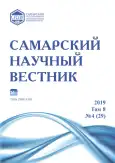Results of the pedagogical experiment on the implementation of the elements of yoga gymnastics while teaching physical culture and sport bachelors
- Authors: Serper S.A.1
-
Affiliations:
- Samara State University of Social Sciences and Education
- Issue: Vol 8, No 4 (2019)
- Pages: 297-301
- Section: Pedagogical Sciences
- URL: https://journal-vniispk.ru/2309-4370/article/view/34509
- DOI: https://doi.org/10.17816/snv201984314
- ID: 34509
Cite item
Full Text
Abstract
The development of new directions in both sports, physical education, and in the field of physical education teaching is an urgent and popular direction in modern pedagogy. This direction is aimed at fulfilling the tasks facing higher education, as well as at implementing state programs to promote the health of the nation. At the present stage of the development of education and science, it is important that state programs are combined with the requirements of Russian society, therefore teachers and methodologists are paying more and more attention to such a direction of health policy as yoga. The scientific and pedagogical study of yoga as an element of sports education is currently at the initial stage. Therefore, the information presented in the paper is of a unique nature: on the basis of a pedagogical experiment, the first conclusions were made about yoga elements integration into physical education and sports education in the new federal standard. The author’s conclusions relate both to methods of solving the problem of motivating students in physical education, and to determining a set of universal competencies that it is advisable to form during the introduction of a new academic discipline based on yoga gymnastics into higher education. The paper emphasizes that the success of this task depends on the integration of the efforts of the state, higher education and fitness centers, which should become the basis for students to practice. The results of the experiment in the control and experimental groups of students give reason to predict that the wider use of yoga gymnastics in the educational process will significantly increase the effectiveness of physical education, as well as will also make graduates more competitive on the labor market.
Full Text
##article.viewOnOriginalSite##About the authors
Sergey Aleksandrovich Serper
Samara State University of Social Sciences and Education
Author for correspondence.
Email: serpersergej@gmail.com
candidate of economical sciences, doctoral candidate
Russian Federation, SamaraReferences
- Кудрявцев М.Д., Галимов Г.Я., Кузьмин В.А., Копылов Ю.А., Гаськов А.В. Эффективность использования в системе физического воспитания студентов нетрадиционных средств на примере хатха-йоги // Вестник Бурятского государственного университета. Выпуск «Физическая культура и спорт». 2014. № 1. С. 41–44.
- Кузьмин В.А., Копылов Ю.А., Кудрявцев М.Д., Толстопятов И.А., Ермаков С.С., Галимов Г.Я. Обоснование эффективности занятий по оздоровительной методике для студентов со сниженным уровнем двигательной подготовленности // Физическое воспитание студентов. 2015. № 6. С. 43–50.
- Беликова Ж.А. Применение гимнастических упражнений хатха-йоги с целью коррекции функциональных нарушений позвоночника у студентов специальных медицинских групп // Культура физическая и здоровье. 2012. Вып. 3. С. 93–101.
- Бернард Т. Хатха-йога. М.: Проспект, 2005. 110 с.
- Копылов Ю.А., Яцковская Л.Н., Кудрявцев М.Д., Кузьмин В.А., Толстопятов И.А., Ермаков С.С. Концепция структуры и содержания оздоровительных занятий для студентов высших учебных заведений // Физическое воспитание студентов. 2015. № 5. С. 23–30.
- Скурихина Н.В., Кудрявцев М.Д., Кузьмин В.А., Ермаков С.С. Фитнес-йога как современная технология укрепления психофизического состояния и психосоциального здоровья студенток специальных медицинских групп // Физическое воспитание студентов. 2016. № 2. С. 25.
- Ахутина Т.В. Здоровьесберегающие технологии обучения: индивидуально-ориентированный подход // Школа здоровья. 2000. Т. 7, № 2. С. 21–28.
- Бальсевич В.К. Физическая подготовка в системе воспитания культуры здорового образа жизни человека // Теория и практика физической культуры. 1990. № 1. С. 22–26.
- Соловьев Г.М. Педагогическая технология формирования физической культуры личности в аспекте современных проблем воспитания // Вестник СГУ. 2000. № 26. С. 20–31.
- Лисицкая Т.С. Принципы оздоровительной тренировки // Теория и практика физической культуры. 2002. № 8. С. 6–14.
- Серпер С.А. Гимнастика йогов в системе формирования общекультурных компетенций у будущих специалистов по физической культуре // Известия Южного федерального университета. Педагогические науки. 2016. № 12. С. 125–132.
- Сайкина Е.Г. Фитнес в системе физической культуры // Известия Российского государственного педагогического университета им. А.И. Герцена. 2008. № 6. С. 31–37.
- Дегтярёва Д.И., Турчина Е.В. Современные фитнес-программы // Физическое воспитание и спортивная тренировка. 2015. № 3. С. 91–95.
- Вашляев Б.Ф. Современное состояние физической культуры и спорта: проблемы и решения // Теория и практика физической культуры. 2010. № 3. С. 5–7.
- Шокина И.Н. Современное физкультурное образование в проекции идеалов гуманизации общества // Поволжский торгово-экономический журнал. 2010. № 3. С. 103–110.
- Калинкин Л.А. Экология и спорт // Теория и практика физической культуры. 1998. № 10. С. 38–45.
- Абзалов P.A., Знятдинова А.И. Экология физической культуры человека // Теория и практика физической культуры. М., 1997. № 7. С. 53–54.
- Клеменцова Н.Н. К становлению понятия общекультурной компетентности: анализ ФГОС ВПО третьего поколения // Вестник Нижневартовского государственного университета. 2016. № 4. С. 24–32.
Supplementary files






